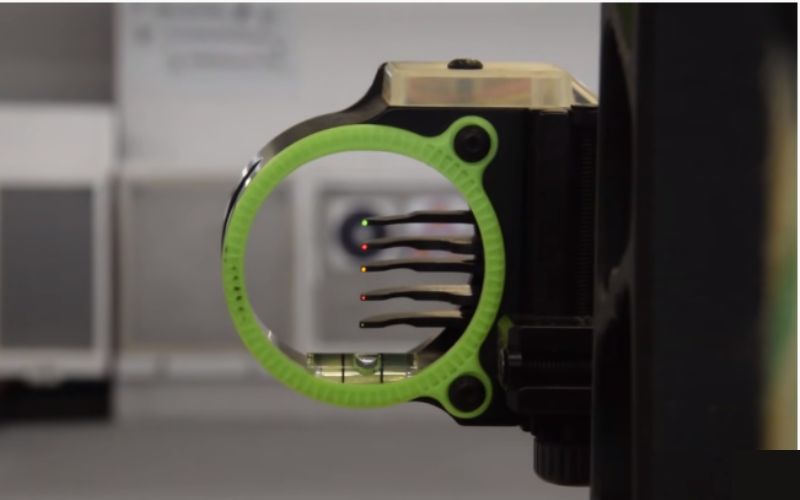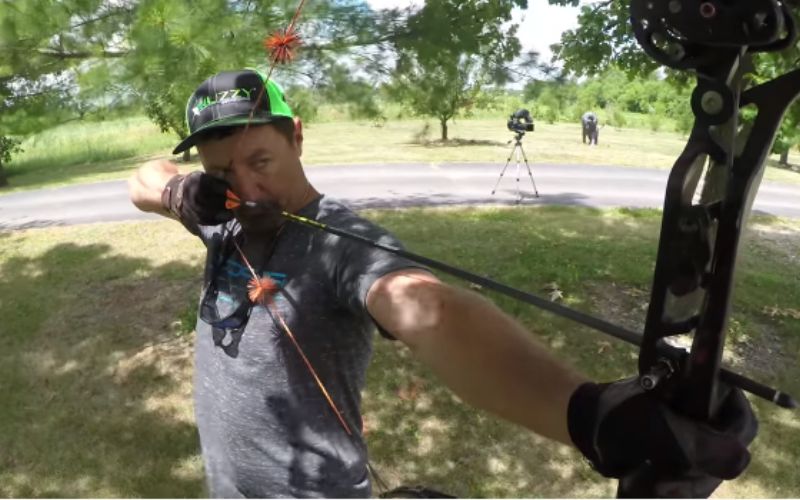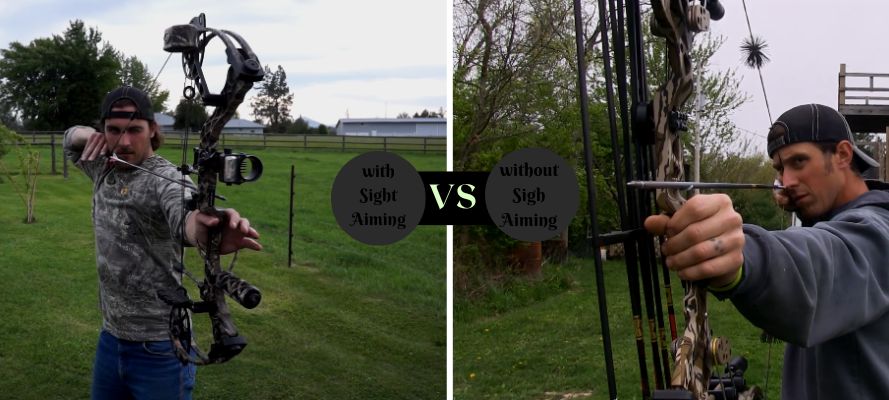After doing some basic training, every archer wants to step up compound bows. Some even start with it straight away. Aiming with a compound bow takes one major consideration: aiming with or without sight.
Sights are a useful aid to line up your shot and help you aim better. But is it a must? Can't you aim without a sight? You can, but you probably won't unless you have a powerful subconscious mind.
Stock compound bows generally come with different kinds of sights. So if you've started using the compound bow, you'll naturally learn to aim using sights first.
But many shooters prefer to practice aiming based on their instincts and without sight. It's challenging and fun. But which is better? Here we'll go over these methods to determine the better option.
Table of Contents
- How To Aim A Compound Bow With Sight
- How To Aim A Compound Bow Without Sights
- When Should You Use Compound Bow With Sight?
- When Should You Use Compound Bow Without Sight?
- Is It Better To Use Compound Bow With Or Without Sight?
- Conclusion
How To Aim A Compound Bow With Sight
Here we'll guide you on how to aim compound bow using the standard sights such as a peep and a multipin sight.
Step 1: Warm Yourself Up
Start preparing yourself when you're ready to aim with your compound bow. Warming yourself up is the best way to ease the tense muscles and eliminate mental stress. So do some stretches to relax the shoulders, neck, upper back muscles, and forearms.
Step 2: Take the Right Position
Take a neutral stance. Place the feet even with each other and at a 90-degree angle with the bow. The hips should be parallel to the bow at full draw. If you prefer a closed stance, step a couple of inches forward with the front foot with weight evenly balanced.
Step 3: Grip Properly
Make sure the bow is tuned well for releasing dead straight arrows. Now grip the bow as it should feel natural to hand, and don't overdo it. Place the forehand palm against its handle like normal and get the bow to full draw with forefingers taken off the handle.
Step 4: Draw the Bow to the Right Anchor Point
Nock your arrow onto the bowstring and draw it back. Your wrist should be relaxed and straight. Now, as you pull the bow and the string comes closer to the face, find an anchor point so that the part of the bow meets the face. Some of the common anchor points to naturally return for the next shot include the cheekbone, below the neck, or the ear.
Step 5: Use the Peep Sight to Look Through
Now it's time to know how to aim a compound bow with a peep sight. This ring-like aiming aid is attached to the bowstring to see through the target while aiming. Make sure you look through it clearly while drawing the bow to the anchor point. Here is a guide on adjusting peep sight properly.
Step 6: Use the Forward Sight to Aim the Target
In this bow sight aiming method, we assume you have the forward sight at your bow's front side. Align it so that the target and the forward sight can be seen through the peep sight.
You can extend the forward sight to increase its distance with the peep sight for a more accurate aim. Check this article to attach your compound bow sight accurately on your bow.

Step 7: Align Your Pin & Check the Bubble Level
The forward sight has multiple pins lined up, such as 20, 30, 40, and 50 yards. Select the pin that you think matches your range. If you're unsure about the range, start with the 20-yard pin and adjust using a trial-and-error method.
Related: Guide To Using Compound Bow Sights
How To Aim A Compound Bow Without Sights
Doing it without sight requires no such aid and is based on instinctive techniques. Two main techniques for it include gap shooting and string walking.
You must repeat the same steps (from the method mentioned above), from tuning the bow to drawing it to the anchor point. The differences start regarding the use of sights. Let's see the details.

Gap Shooting Method of Aiming without Sight
Gap shooting is a technique used by archers or hunters who don't use a sight on their bows. This technique requires refining the aim of the shots after firing each arrow. Let's see how to aim compound bow with gap shooting:
Step 1: Use the Point of Your Arrow as the Sight Picture
We assume you've prepared well, positioned right, and gripped the bow perfectly. As you nock the arrow on the bow and draw the bow to the anchor point, use the point of your arrow as the 'sight picture.'
Step 2: Shoot and Use the First Shot as a Marker
Use any of your preferred release methods like split-finger or 3-finger under to shoot the target. Now mark your first shot and try to understand and mentally record the impact & direction of the arrow from the bullseye.
Step 3: Find Your Gap
Let's say you have started at the 5-yard distance and placed the arrow's tip on the bullseye. The arrow should've impacted high after releasing the shot. If the arrow impacts 6 inches high, your gap at 5 yards is 6 inches. And you've to place the arrow tip 6 inches below the target to hit the bullseye at this gap.
Step 4: Point the Arrow Below or Above the Target
Now increase the distance at different set intervals like 10,15,20,25,30,35, and 40 yards. Calculate your arrow's impact at every interval. Every time place the tip of the arrow below or above the target based on the impact of the most recent shot as discussed above.
Typically, a shorter distance (or gap) will have a higher impact, and you need to place the arrow below the target. And for longer distances, it's the opposite. After mapping out all the gaps, you should know where to place the arrow at a particular gap to hit the bullseye.
String Walking Method To Aim Without Sight
String walking is another technique to aim your compound bow without sight. It's based on the position of your fingers holding the bowstring during a shot.
Step 1: Place Your Finger In an Optimal Position
In this method, you've to place the fingers on the bowstring where you think you can aim the shot most accurately.
Step 2: Use a Measuring Device to Track
The best way to track where you place your finger on the bowstring is to use String Tab. This device lets you map your finger positions on the bowstring against the impact of your shot.
Step 3: Adjust Your Fingers By Moving them Up or Down
If you've got a higher anchor point and want the shot to land lower to reach the target, place your fingers lower on the bowstring while drawing the arrow. And to hit it higher on the target, do the opposite, draw your bowstring back with fingers positioned higher.
When Should You Use Compound Bow With Sight?
Sights are widely used with compound bows for hunting, archery, target practicing, and any instance where the target distance is known. Sights can lift the shooting performance by providing the following benefits.
- Magnifying target with a clearer visibility
- Eliminates the distractions and camouflaging around the target
- Provides more visibility details
- Improves aiming and shooting accuracy
- It makes the eyes strain-free and relaxing with a magnified sight of the distant object.
When Should You Use Compound Bow Without Sight?
Instinctive aiming or aiming without sight is a bit more challenging. People use compound bows without sight in instinctive archery and some hunting conditions to get the following benefits:
- It removes the guesswork and promotes shooting skills without aid.
- Instincts get developed by practicing different techniques that help in spontaneous shooting instances like bowhunting.
Is It Better To Use Compound Bow With Or Without Sight?
Which is better: compound bow with sight? Or Without sight? Let's find out which one excels where.
When It's Better to Use a Compound Bow With Sight
If you know how to aim a compound bow with pin sights and the peep sight precisely, you could change the game! Although Olympics doesn't use it, compound bows are used in many international competitions, and it's legal to use release aids like sights.
Sights also make a better addon for bowhunting and target practicing. You can make accurate shots by adjusting the sights' pin precisely while targeting the desired range. However, the sights won't help you much when the distance or range is unknown.
When It's Better to Use a Compound Bow Without Sight
Compound bow users tend to use sights when the target's distance is known, but when it changes or varies, aiming without sights can come in handy. Many pro shooters don't use sights during bow hunting or target practicing.
Instinctive shooting has been an old age method, and many have used it for different hunting situations and survival. It makes a better choice for competitions that don't allow sights and also for some hunting situations that require intuitive shooting skills.
Conclusion
Aiming a compound bow requires a fair amount of training, regardless of whether you use it with sight or without one. However, you need to know how these methods (with and without sights) work to compare the benefits and determine the better option.
We'd say one should bag both these skills. You can do target practicing better while aiming a compound bow with sight. But when there's no fixed range, and you're considering some bowhunting, instinctive aiming (without sights) could make a better choice.
Links of Connected Articles:

